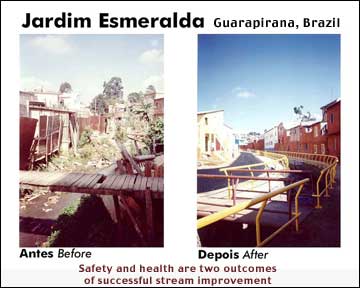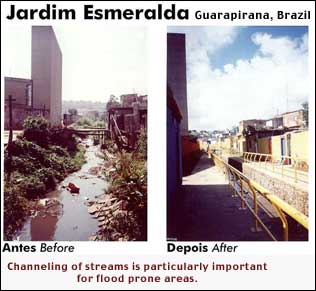|
|||||||||||||
GUARAPIRANGA, BRAZILExample of: • Integrated Urban Management• Prevention of Future Land Invasions |
|||||||||||||
 |
Sao Paulo, Brazil |
||||||||||||
|
|
|||||||||||||
|
Summary
|
This World Bank urban water quality management project is often described as a “model urban development project.” The upgrading component possesses an integrated, interagency approach involving five agency/government bodies and has created a precedent for interagency cooperation in urban development projects. It also helped restore public authority in slum areas where there was a high crime rate.
|
||||||||||||
|
For further information:
|
Mejia, Abel and Bakalian, Alex. “Urban Stormwater Drainage in Brazil: Issues and Implications.” Infrastructure Notes TWUWS-2. (Washington, D.C.: Transportation, Water and Urban Development Department, World Bank, December 1992).
|
||||||||||||
 |
|||||||||||||
|
Objectives
|
|||||||||||||
|
Components
|
Some of the urban components included:
|
||||||||||||
 |
|||||||||||||
|
Lessons:
What worked and why? |
The project avoided the problem of resettlement by upgrading the land invasions along the riparian corridor. To protect open land from further invasions, they created multiple function parks that also serve as environmental education centers and provide open space and recreation.
|
||||||||||||
|
What didn't work and why?
|
Financial and cost recovery aspects were not so strong. “Municipality works” were justified on the basis of increased tax revenues from increased income in the slum areas, but this was not realistic.
|
||||||||||||
|
Tips:
|
|||||||||||||
|
To Learn More:
|
Bartone, Carl and Rodriguez, Emilio. “Watershed Protection in the Sao Paulo Metropolitan Region: A Case Study of an Issue-Specific Urban Environmental Management Strategy.” Infrastructure Notes UE-9. (Washington, D.C.: Transportation, Water and Urban Development Department, World Bank, April, 1993) “Brazil’s Troubled Megalopolis.” The Economist. (May 23 1998): 34. |
||||||||||||
|
|||||||||||||
